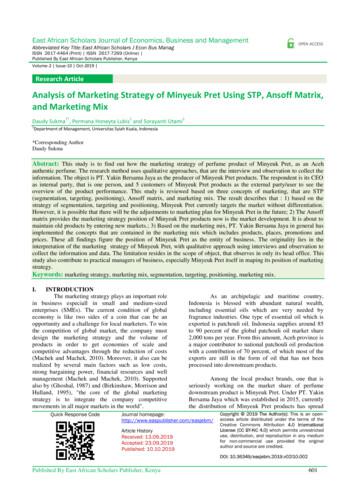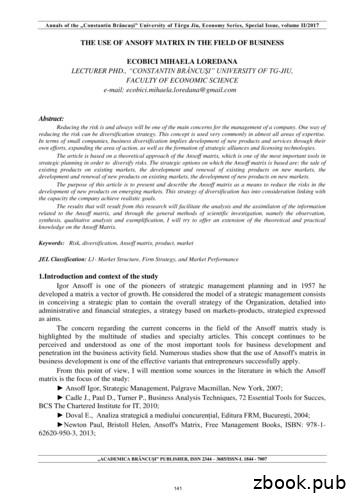The Ansoff Matrix - Michigan Scouting
The Ansoff MatrixUnderstanding the Risks of Different OptionsAlso known as the Product/Market ExThere arerewards andrisks withgrowthstrategies. iStockphoto IrochkaTSuccessful leaders understand that if their organization is to grow in the long term,they can't stick with a "business as usual" mindset, even when things are going well.They need to find new ways to increase profits and reach new customers.There are numerous options available, such as developing new products or opening upnew markets, but how do you know which one will work best for your organization?This is where you can use an approach like the Ansoff Matrix to think about thepotential risks of each option, and to help you devise the most suitable plan for yoursituation.Understanding the ToolThe Ansoff Matrix was developed by H. Igor Ansoff and first published in theHarvard Business Review in 1957, in an article titled "Strategies forDiversification ." It has given generations of marketers and business leaders a quickand simple way to think about the risks of growth.
Sometimes called the Product/Market Expansion Grid, the Matrix (see Figure 1,below) shows four strategies you can use to grow. It also helps you analyze the risksassociated with each one. The idea is that, each time you move into a new quadrant(horizontally or vertically), risk increases.Figure 1: The Ansoff MatrixNewExistingExistingProducts andServicesNewThe Corporate Ansoff MatrixLet's examine each quadrant of the Matrix in more detail.Market penetration, in the lower left quadrant, is the safest of the four options. Here,you focus on expanding sales of your existing product in your existing market: youknow the product works, and the market holds few surprises for you.Product development, in the lower right quadrant, is slightly more risky, becauseyou're introducing a new product into your existing market.With market development, in the upper left quadrant, you're putting an existingproduct into an entirely new market. You can do this by finding a new use for theproduct, or by adding new features or benefits to it.
Diversification, in the upper right quadrant, is the riskiest of the four options, becauseyou're introducing a new, unproven product into an entirely new market that you maynot fully understand.How to use the ToolIt's fairly straightforward to use the Ansoff Matrix to weigh up the risks associatedwith a number of strategic options.Step 1: Analyze Your OptionsDownload our free Corporate Ansoff Matrix Worksheet. Then plot the approachesyou're considering on the Matrix. The table below helps you think about how youmight classify different approaches.Here, you're targeting new markets, or newareas of your existing market. you're trying tosell more of the same things to different people.Here you might:This strategy is risky: there's often little scopefor using existing expertise or for achievingeconomies of scale, because you are trying tosell completely different products or services todifferent customers Target different geographical markets at Beyond the opportunity to expand yourh ome or abroad . Conduct a PESTb .h· df d""fi ·usmess, t e mam a vantage o 1vers1 1cahon.h CAGE .0 1stance ,. . th t h ldAnaIys1s Cor use t e·v lSa , s ou one bus1nesssuf""ier fromFramework Oto identify opportunitiesand threats in this different market. Use different sales channels, such asonline or direct sales, if you areadverse circumstances, another may not beaffected.
currently selling through agents orintermediaries. Use Market Segmentation Oto targetdifferent groups of people, perhaps withdifferent age, gender or demographicprofiles from your usual customers. Use the marketing mix Oto understandhow to reposition your product.Market PenetrationWith this approach, you're trying to sell more ofthe same things to the same market. Here youmight:Product Development Develop a new marketing strategy Otoencourage more people to choose your Here, you're selling different products to ·thesame people, so you might:product, or to use more of it. Introduce a loyalty scheme. Launch price or other special offerpromotions. Increase your sales force's activities. Use the Boston Matrix to decidewhich products warrant furtherinvestment, and which should bedisregarded. Buy a competitor company (particularlyin mature markets). Extend your product by producingdifferent variants, or repackage existingproducts. Develop related products or services. In a service industry, shorten your timeto market, or improve customer serviceOor quality.Reprinted by permission of Harvard Business Review. From "Strategies forDiversification" by H. Igor Ansoff, 1957. Copyright 1957 by the Harvar d BusinessSchool Publishing Corporation; all rights reserved.
Step 2: Manage RisksConduct a Risk Analysis Oto gain a better understanding of the dangers associatedwith each option. (If there are a lot of these, prioritize them using a RiskImpact/Probability Chart .) Then, create a contingency plan o that addresses theones you're most likely to face.Step 3: Choose the Best OptionBy now, you might have a sense of which option is right for you and yourorganization. You can make sure it really is the best one with one last step: useDecision Matrix Analysis Oto weigh up the different factors in each option, andmake the best choice.Using a Nine-Box Ansoff MatrixSome marketers use a nine-box grid for a more sophisticated analysis. This puts"modified" products between existing and new ones (for example, a different flavor ofyour existing pasta sauce rather than launching a soup), and "expanded" marketsbetween existing and new ones (for example, opening another store in a nearby town,rather than expanding internationally).This is useful as it shows the difference between product extension and true productdevelopment, and also between market expansion and venturing into genuinely newmarkets (see Figure 2, below).However, be careful of the three "options" in orange, as they involve trying to do twothings at once without the one benefit of a true diversification strategy: completelyescaping a downturn in a single-product market.Figure 2: The Nine-Box Grid
Step 2: Manage RisksConduct a Risk Analysis to gain a better understanding of the dangers associatedwith each option. (If there are a lot of these, prioritize them using a RiskImpact/Probability Chart o .) Then, create a contingency plan o that addresses theones you're most likely to face.Step 3: Choose the Best OptionBy now, you might have a sense of which option is right for you and yourorganization. You can make sure it really is the best one with one last step: useDecision Matrix Analysis to weigh up the different factors in each option, andmake the best choice.Using a Nine-Box Ansoff MatrixSome marketers use a nine-box grid for a more sophisticated analysis. This puts"modified" products between existing and new ones (for example, a different flavor ofyour existing pasta sauce rather than launching a soup), and "expanded" marketsbetween existing and new ones (for example, opening another store in a nearby town,rather than expanding internationally).This is useful as it shows the difference between product extension and true productdevelopment, and also between market expansion and venturing into genuinely newmarkets (see Figure 2, below).However, be careful of the three "options" in orange, as they involve trying to do twothings at once without the one benefit of a true diversification strategy: completelyescaping a downturn in a single-product market.Figure 2: The Nine-Box Grid
Decision Matrix Analysis to weigh up the different factors in each option, and make the best choice. Using a Nine-Box Ansoff Matrix Some marketers use a nine-box grid for a more sophisticated analysis. This puts "modified" products between existing and new ones (for example, a different flavor of
May 02, 2018 · D. Program Evaluation ͟The organization has provided a description of the framework for how each program will be evaluated. The framework should include all the elements below: ͟The evaluation methods are cost-effective for the organization ͟Quantitative and qualitative data is being collected (at Basics tier, data collection must have begun)
Silat is a combative art of self-defense and survival rooted from Matay archipelago. It was traced at thé early of Langkasuka Kingdom (2nd century CE) till thé reign of Melaka (Malaysia) Sultanate era (13th century). Silat has now evolved to become part of social culture and tradition with thé appearance of a fine physical and spiritual .
On an exceptional basis, Member States may request UNESCO to provide thé candidates with access to thé platform so they can complète thé form by themselves. Thèse requests must be addressed to esd rize unesco. or by 15 A ril 2021 UNESCO will provide thé nomineewith accessto thé platform via their émail address.
̶The leading indicator of employee engagement is based on the quality of the relationship between employee and supervisor Empower your managers! ̶Help them understand the impact on the organization ̶Share important changes, plan options, tasks, and deadlines ̶Provide key messages and talking points ̶Prepare them to answer employee questions
Dr. Sunita Bharatwal** Dr. Pawan Garga*** Abstract Customer satisfaction is derived from thè functionalities and values, a product or Service can provide. The current study aims to segregate thè dimensions of ordine Service quality and gather insights on its impact on web shopping. The trends of purchases have
The Concept of Ansoff Growth Matrix Strategy In this study, the most appropriate strategy which is applied to PT. Yakin Bersama Jaya in order to penetrate the international market based on Ansoff growth matrix strategy concept is the third strategy, namely market development. The strategy is that PT.
3.The Ansoff Matrix - Theory and Methodology The Ansoff Matrix, created by the American planning expert Igor Ansoff, ia a strategic planning tool that links an organisation's marketing strategy with its general strategic direction. It presents four alternative growth strategies in the form of a 2x2 table or matrix. One dimension of
Description Logic: A Formal Foundation for Ontology Languages and Tools Ian Horrocks Information Systems Group Oxford University Computing Laboratory Part 1: Languages . Contents Motivation Brief review of (first order) logic Description Logics as fragments of FOL Description Logic syntax and semantics Brief review of relevant complexity .























